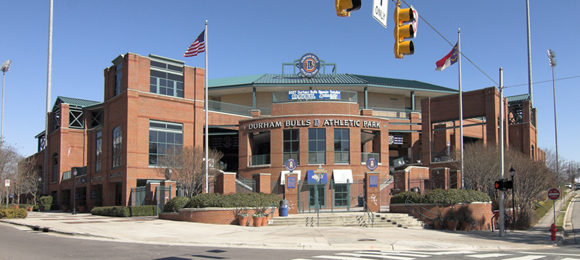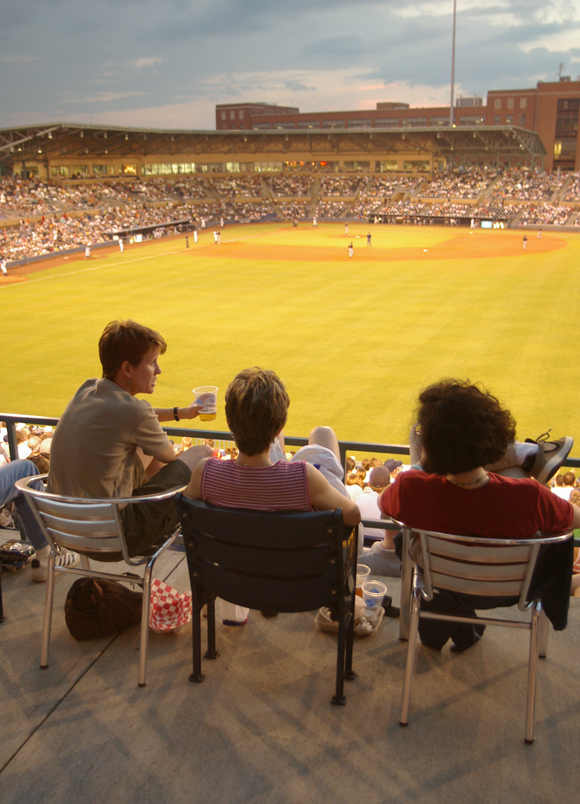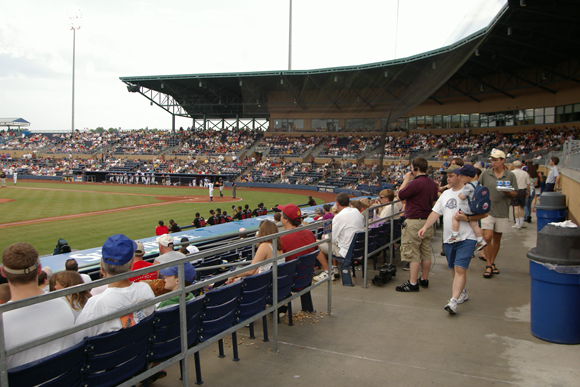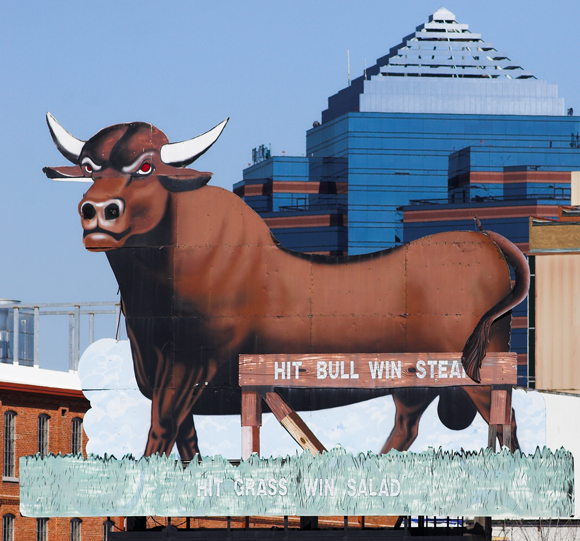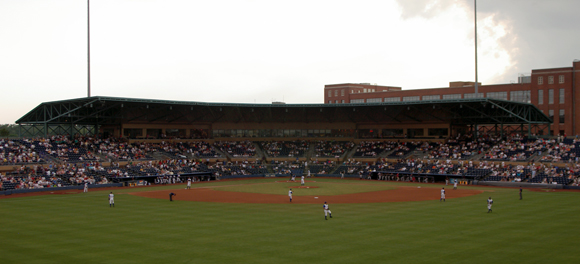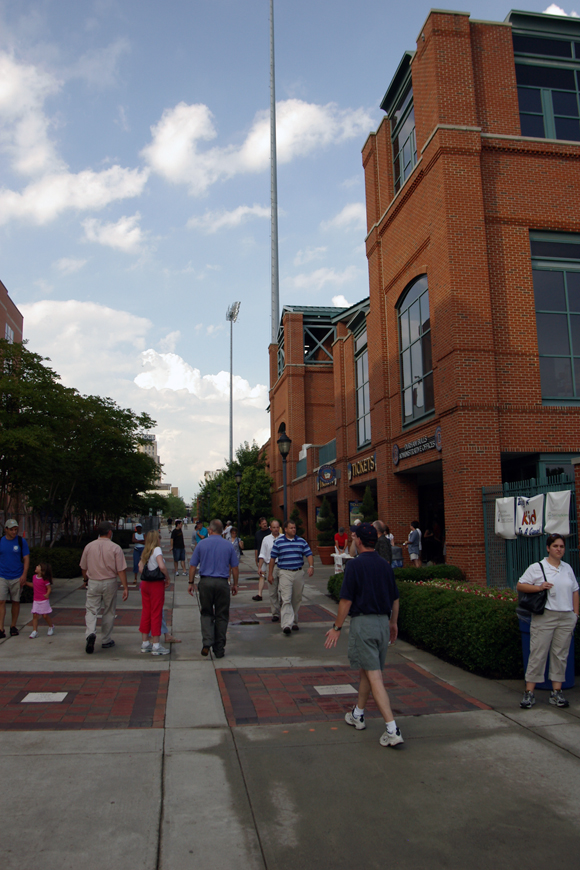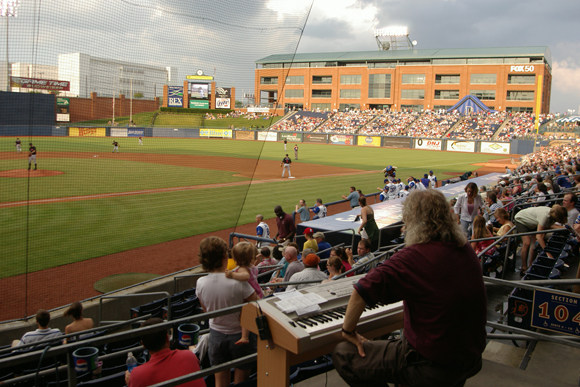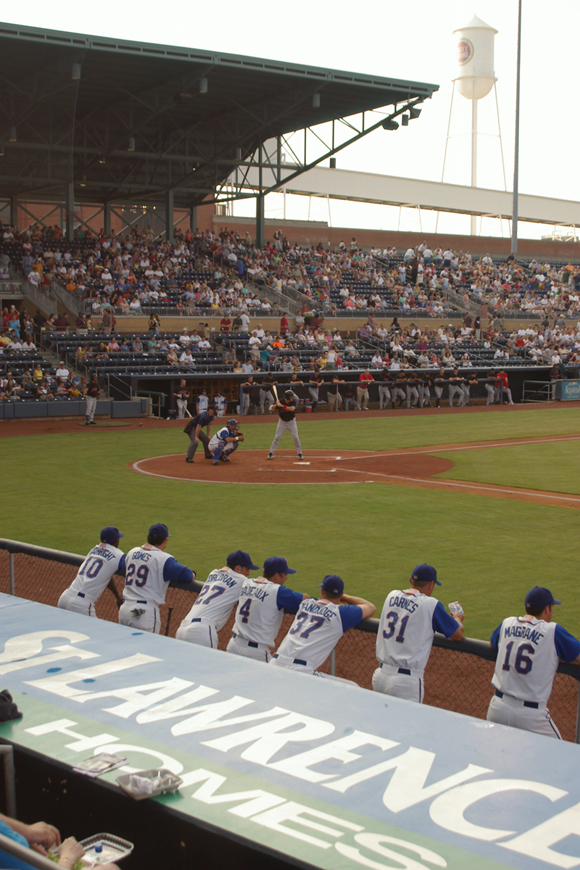The Durham Bulls don’t play any longer at classic Durham Athletic Park, but Durham Bulls Athletic Park captures the spirit of a classic Carolina League park while providing all the amenities sought by today’s baseball fan. It is, after more than a decade, a classic ballpark of the minor leagues, aging quite nicely as the Bulls have made small, crucial improvements almost yearly to a great ballpark. For many, Durham is the center of the American baseball world (sorry, Cooperstown), and Durham Bulls Athletic Park is the hub of Durham baseball. Page 1: Fast Facts, Introduction.
Year Opened: 1995
Cost: $16 million
Capacity: 10,000
Suites: 12
Dimensions: 305L, 400C, 327R
Architect: Populous
Owner: City of Durham
Website: durhambulls.com
Phone: 919/956-BULL
League: International League (Class AAA)
Affiliation: Tampa Bay Devil Rays
Parking: If you get to the ballpark early enough you can park for free on Willard Street west of the ballpark. Otherwise, the most convenient parking location is the American Tobacco South Parking deck, located next to the ballpark at 512 S. Mangum St. The charge: $3.
Address/Directions: 409 Blackwell St., Durham. Some of the freeway signs pointing the direction to Durham Bulls Athletic park can be a tad misleading, so don’t follow them. The easiest way to the ballpark is to get on the Durham Freeway, which can be accessed from I-40. When on I-40, take the Magnum/Roxboro Street exit (exit 12B). You’ll be able to see the ballpark from the exit.Durham is the most storied minor-league market thanks to the amazing popularity of the movie Bull Durham, which featured Kevin Costner as a battered catcher making one last minor-league stop with the Durham Bulls. Featured prominently in the movie was Durham Athletic Park and a wooden bull that would snort after a home run.
Despite seating 10,000, DBAP is a single-level ballpark; most Class AAA parks seating that many are double-decked ballparks, but Populous and the Bulls avoided stacking a second deck by stretching seating all the way down the line and curving it around the foul pole in right field. There are three entrances to the ballpark: the main entrance (pictured on the first page of this article) as well as smaller gates in the left-field corner and in dead center field. Seating in the grandstand is divided into two levels, with a wide walkway dividing the two. Down each line are two group seating areas with picnic tables. Every fixed seat in the ballpark is an extra-wide theater seat (there are no bleachers), and 95 percent of the seats have drink holders. There really aren’t any bad seats in the house: the outfield bleachers are close to the action, and for those who want to stretch out there is berm seating in centerfield near the scoreboard.
The Durham Bulls don’t play any longer at classic Durham Athletic Park, but Durham Bulls Athletic Park captures the spirit of a classic Carolina League park while providing all the amenities sought by today’s baseball fan. It is, after more than a decade, a classic ballpark of the minor leagues, aging quite nicely as the Bulls have made small, crucial improvements almost yearly to a great ballpark. For many, Durham is the center of the American baseball world (sorry, Cooperstown), and Durham Bulls Athletic Park is the hub of Durham baseball. Page 2: A Classic Grandstand; A Lot of Bull.
The roof that covers the main grandstand and the luxury-box level is strongly reminiscent of a roof you can still find in most older ballparks; it looks like and is scaled like an old wooden grandstand roof. (It’s also functional: as you can tell from the photos of this visit, it was a rainy evening, and the roof provided shelter to the fans who arrived early for the game.) The Bulls employ an organist; he’s positioned in back of the inner set of seats. A 32-foot-high “Blue Monster” wall in left field — which serves no purpose save a nostalgic one — and a hand-operated scoreboard complete the old-time feel of the ballpark.
Above the wall is a bull. One of the recurring motifs in Bull Durham was the presence of a bull in right field that would snort when struck by a home run. The bull above the Blue Monster is not the same one used in the movie; that is one is located in the concourse. The bull built for the movie was indeed a part of the old Durham Athletic Park from 1988 through 1994: the film crew left the bull intact.
The Durham Bulls don’t play any longer at classic Durham Athletic Park, but Durham Bulls Athletic Park captures the spirit of a classic Carolina League park while providing all the amenities sought by today’s baseball fan. It is, after more than a decade, a classic ballpark of the minor leagues, aging quite nicely as the Bulls have made small, crucial improvements almost yearly to a great ballpark. For many, Durham is the center of the American baseball world (sorry, Cooperstown), and Durham Bulls Athletic Park is the hub of Durham baseball. Page 3: Recent Changes.
Speaking of the concourse: most of the action in the ballpark, including the majority of concessions and restrooms, are located in the grandstand. You’ll want to arrive early to the ballpark and walk the concourse: colorful murals illustrate the history of baseball in the Triangle, which goes above and beyond Bull Durham. Yes, Bull Durham is the movie that put the Bulls on the map and truly changed how Minor League Baseball was marketing and sold. Previously there was no such thing as national marketing of minor-league marks, but fans wanting to have a piece of the movie flooded the team and other merchandisers with requests for hats, T-shirts and more.
One improvement made in recent seasons: new construction connected walkways in the outfield between left and center field, making Durham Bulls Athletic Park a ballpark with a wraparound concourse. This feature was missing for more of a decade, and it made for some dead ends in the outfield.
The Durham Bulls don’t play any longer at classic Durham Athletic Park, but Durham Bulls Athletic Park captures the spirit of a classic Carolina League park while providing all the amenities sought by today’s baseball fan. It is, after more than a decade, a classic ballpark of the minor leagues, aging quite nicely as the Bulls have made small, crucial improvements almost yearly to a great ballpark. For many, Durham is the center of the American baseball world (sorry, Cooperstown), and Durham Bulls Athletic Park is the hub of Durham baseball. Page 4: A Sea of Brick.
Arriving at the ballpark from almost any angle will expose you to a sea of brick; the exterior echoes both Durham Athletic Park and the brick buildings in the area. A newer building housing other businesses associated with the Bulls ownership sits in right field, while on the first-base side of the ballpark is the American Tobacco Historic District, which converted old tobacco-company warehouses and office space into a mixed-used developer that combines retail, commercial and residential space. You can see the former Lucky Strike manufacturing plant in the background of the photos in this story; if you look closely you can see the Lucky Strike logo on the water tower. (The city of Durham built the ballpark, but the ownership of the Bulls are benefiting: the American Tobacco Historic District redevelopment is being done by team owner Capitol Broadcasting Company.)
At DBAP here’s little of the circus atmosphere you find at most minor-league baseball games: the emphasis is on baseball, and the local fans are smart enough to know a good play and how to appreciate the game.
All in all, Durham Bulls Athletic Park is a great place to watch a baseball game and is certainly one of the finest ballparks in minor-league baseball. There really is not a bad seat in the house, and Durham fans love their baseball — a combination that makes for a great night at the ballpark.
The Durham Bulls don’t play any longer at classic Durham Athletic Park, but Durham Bulls Athletic Park captures the spirit of a classic Carolina League park while providing all the amenities sought by today’s baseball fan. It is, after more than a decade, a classic ballpark of the minor leagues, aging quite nicely as the Bulls have made small, crucial improvements almost yearly to a great ballpark. For many, Durham is the center of the American baseball world (sorry, Cooperstown), and Durham Bulls Athletic Park is the hub of Durham baseball. Page 5: History, Food and More.
History
The Durham Bulls originally began play in 1902 in George Lyon Ball Park, competing in the North Carolina State Professional Baseball League. The name was a natural: Durham was a leader in the tobacco industry, and Bull Durham was the most popular brand.
By 1926 the ballpark had a new name — El Toro Park — but by 1933 it had been renamed Durham Athletic Park. The park was located near Durham’s downtown tobacco warehouses, and the Bulls drew heavily from warehouse workers. In June 1939 Durham Athletic Park was severely damaged by fire, but within two weeks the ballpark was better than ever and served as the home of the Bulls until 1995, when Durham Bulls Athletic Park opened.
After the Bulls moved into Durham Bulls Athletic Park, Durham Athletic Park sat empty, save for some occasional concerts. For a few years a college wood-bat Coastal Plain League team played there, through 2003.
Today Durham Athletic Park is slated for renovation. Minor League Baseball has committed to running an umpire school there, and there’s talk about further development as a minor-league museum.
Concessions
All of the main concession stands are located in the back of the grandstand. There’s a wide variety of offerings: regular ballpark fare (hot dogs, burgers, pizza, nachos, et al), Mexican, barbeque, fried chicken and more. Recommended: the barbequed pork sandwich, any Berk’s hot dog (and several kinds are sold at the ballpark), or the 24-ounce Pabst Blue Ribbon tallboys sold by almost every beer vendor.
We’d recommend the barbeque: it comes from Dillard’s, a local outfit that’s sold Carolina-style (i.e,, vinegary sauce) barbeque for more than 50 years. They take their barbecue seriously in North Carolina, and Dillard’s is regarded as one of the top vendors in the state.
Also possessing a little history: the Flying Burrito, which also had a stand at the old ballpark.
Watch out for some of the prices, however. While admission to the ballpark is relatively cheap, some of the concession prices are not: a “souvenir” beer runs you $6 and a specialty draft beer costs $4.25.

